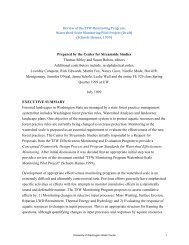Copyright 2012 Aileen M. Echiverri-Cohen - University of Washington
Copyright 2012 Aileen M. Echiverri-Cohen - University of Washington
Copyright 2012 Aileen M. Echiverri-Cohen - University of Washington
Create successful ePaper yourself
Turn your PDF publications into a flip-book with our unique Google optimized e-Paper software.
disambiguate the original fear association between the CS and UCS. Similar to the<br />
pharmacotherapy and PTSD literature, no studies have examined changes in inhibitory<br />
functioning directly with psychotherapy in PTSD. Yet, there is preliminary evidence for<br />
improved inhibitory functioning with psychotherapy. Given the role <strong>of</strong> the mPFC in the<br />
inhibitory learning that occurs during extinction in animals (Milad et al., 2002), the mPFC is also<br />
believed to play a similar role in the inhibitory learning that occurs in exposure therapy in<br />
humans (Nutt & Malizia, 2004).<br />
Three preliminary studies, although not directly looking at inhibition, show functional<br />
improvements in the inhibitory-related, cortico-prefrontal circuitry following psychosocial PTSD<br />
treatments (Felmingham et al., 2007; Levin, Lazrove, & van der Kolk, 1999). Felmingham et al.<br />
(2007) presented eight individuals with PTSD with a symptom provocation task using stimuli<br />
made up <strong>of</strong> fearful and neutral facial expressions before and after eight sessions <strong>of</strong> imaginal<br />
exposure and cognitive restructuring. Although there was no differential amygdala activity at<br />
either pre-treatment or six month follow-up, these individuals showed increased rostral anterior<br />
cingulate cortex (rACC) activity during fear processing from pre-treatment to follow-up. Further,<br />
increased changes from pre-treatment to follow-up on anterior cortex activity were correlated<br />
with a reduction in PTSD symptoms (Felmingham et al., 2007). Similarly, a functional magnetic<br />
resonance imaging study (fMRI; Kim, 2006) examined individuals with PTSD treated with PE<br />
before and after treatment. Notably, there was in increase in activation <strong>of</strong> the Broca's area from<br />
pre- to post-treatment, presumably reflecting cognitive processing <strong>of</strong> the traumatic experience<br />
and improvement in PTSD. Finally, Levin et al. (1999) presented a case study <strong>of</strong> a man who was<br />
abused as a child and treated with three, weekly EMDR sessions from pre- to post-treatment.<br />
Although on an antidepressant during EMDR, the authors found that increased resting anterior<br />
14
















